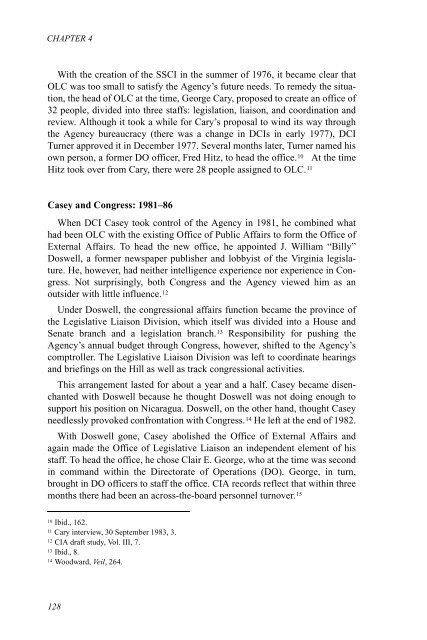CHAPTER 4 - Central Intelligence Agency
CHAPTER 4 - Central Intelligence Agency
CHAPTER 4 - Central Intelligence Agency
Create successful ePaper yourself
Turn your PDF publications into a flip-book with our unique Google optimized e-Paper software.
<strong>CHAPTER</strong> 4<br />
With the creation of the SSCI in the summer of 1976, it became clear that<br />
OLC was too small to satisfy the <strong>Agency</strong>’s future needs. To remedy the situation,<br />
the head of OLC at the time, George Cary, proposed to create an office of<br />
32 people, divided into three staffs: legislation, liaison, and coordination and<br />
review. Although it took a while for Cary’s proposal to wind its way through<br />
the <strong>Agency</strong> bureaucracy (there was a change in DCIs in early 1977), DCI<br />
Turner approved it in December 1977. Several months later, Turner named his<br />
own person, a former DO officer, Fred Hitz, to head the office. 10 At the time<br />
Hitz took over from Cary, there were 28 people assigned to OLC. 11<br />
Casey and Congress: 1981–86<br />
When DCI Casey took control of the <strong>Agency</strong> in 1981, he combined what<br />
had been OLC with the existing Office of Public Affairs to form the Office of<br />
External Affairs. To head the new office, he appointed J. William “Billy”<br />
Doswell, a former newspaper publisher and lobbyist of the Virginia legislature.<br />
He, however, had neither intelligence experience nor experience in Congress.<br />
Not surprisingly, both Congress and the <strong>Agency</strong> viewed him as an<br />
outsider with little influence. 12<br />
Under Doswell, the congressional affairs function became the province of<br />
the Legislative Liaison Division, which itself was divided into a House and<br />
Senate branch and a legislation branch. 13 Responsibility for pushing the<br />
<strong>Agency</strong>’s annual budget through Congress, however, shifted to the <strong>Agency</strong>’s<br />
comptroller. The Legislative Liaison Division was left to coordinate hearings<br />
and briefings on the Hill as well as track congressional activities.<br />
This arrangement lasted for about a year and a half. Casey became disenchanted<br />
with Doswell because he thought Doswell was not doing enough to<br />
support his position on Nicaragua. Doswell, on the other hand, thought Casey<br />
needlessly provoked confrontation with Congress. 14 He left at the end of 1982.<br />
With Doswell gone, Casey abolished the Office of External Affairs and<br />
again made the Office of Legislative Liaison an independent element of his<br />
staff. To head the office, he chose Clair E. George, who at the time was second<br />
in command within the Directorate of Operations (DO). George, in turn,<br />
brought in DO officers to staff the office. CIA records reflect that within three<br />
months there had been an across-the-board personnel turnover. 15<br />
10<br />
Ibid., 162.<br />
11<br />
Cary interview, 30 September 1983, 3.<br />
12<br />
CIA draft study, Vol. III, 7.<br />
13<br />
Ibid., 8.<br />
14<br />
Woodward, Veil, 264.<br />
128
















